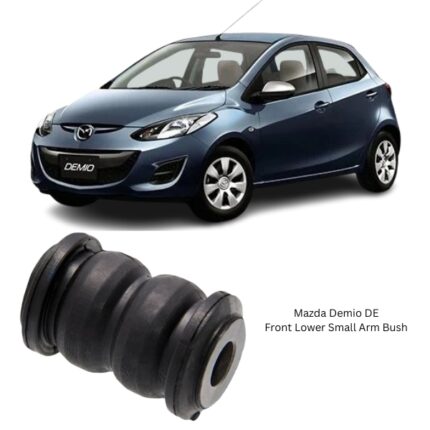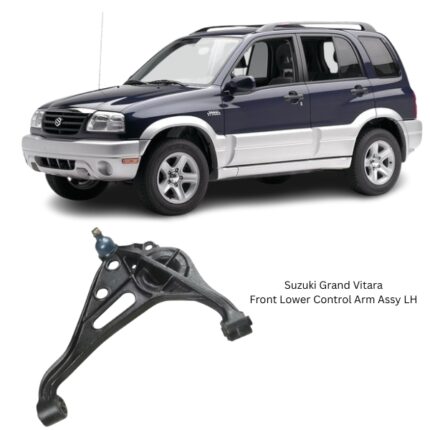Get Suzuki Grand Vitara Front Lower Control Arm Assy LH 45201-67D01 in Kenya
The Front Lower Control Arm Assembly LH (Left Hand) is one of the most vital components in a vehicle’s front suspension system. It connects the wheel hub and steering knuckle to the vehicle’s chassis, serving as a crucial link that governs both the vertical and horizontal movement of the front left wheel. This control arm is responsible for maintaining proper alignment and handling, absorbing road impacts, and ensuring smooth steering dynamics. Its structural integrity and precise function are critical to both safety and driving comfort.
1. Overview and Purpose
The primary function of the Front Lower Control Arm Assembly LH is to:
-
Control Vertical Motion: It allows the wheel to move up and down independently of the chassis, absorbing bumps and road irregularities.
-
Maintain Wheel Alignment: It ensures the wheel stays in proper alignment relative to the vehicle’s body, contributing to accurate steering and reduced tire wear.
-
Support Load Transfer: It carries vertical loads from the suspension to the chassis and helps manage lateral (sideways) forces during turns.
-
Facilitate Steering Geometry: It supports the geometry required for predictable and stable cornering, braking, and acceleration.
The control arm works in conjunction with other components such as the strut assembly, stabilizer bar, and upper arm (if equipped), forming a triangle-like configuration commonly referred to as an A-arm or wishbone design.
2. Components of the Assembly
A typical Front Lower Control Arm Assembly LH consists of several subcomponents integrated into a single functional unit:
-
Control Arm Body: Usually made from stamped steel, forged steel, or lightweight aluminum alloy for strength and durability. Its shape is often curved or V-shaped for optimal load distribution and space utilization.
-
Ball Joint: A pivotal joint at the outer end that connects to the steering knuckle, allowing it to rotate and pivot with the wheel’s steering and suspension movement.
-
Bushings: Located at the inner end of the control arm, these rubber or polyurethane inserts isolate road vibrations, permit slight movement, and anchor the arm to the subframe or chassis.
-
Mounting Brackets or Sleeves: Integrated to support attachment points for bolts or hardware.
Each of these elements is engineered to withstand specific mechanical stresses—shear, tension, and compression—during a vehicle’s operation.
3. Materials and Construction
The choice of material and manufacturing technique for the control arm is crucial:
-
Steel: Offers high tensile strength and impact resistance, making it ideal for standard and heavy-duty vehicles.
-
Aluminum: Lighter than steel, helps reduce unsprung weight for better fuel efficiency and ride quality. However, it may be less impact-resistant.
-
Forged Alloys: Provide superior strength and fatigue resistance, often used in performance vehicles.
The assembly is often treated with corrosion-resistant coatings or paint to extend service life in harsh conditions.
4. Placement and Installation
The LH (Left Hand) designation refers to the driver’s side in left-hand drive vehicles (or passenger side in right-hand drive systems). Proper installation of the Front Lower Control Arm Assembly LH is essential for maintaining correct suspension geometry.
The control arm is typically mounted to:
-
The chassis or subframe through bushings and bolts.
-
The steering knuckle via the ball joint.
During installation or replacement, alignment procedures are necessary to ensure that camber and caster angles remain within manufacturer specifications.
5. Role in Suspension Dynamics
The Front Lower Control Arm Assembly LH plays a critical role in:
-
Ride Comfort: Absorbs shocks and vibrations through its bushings and pivot points.
-
Handling Precision: Maintains wheel alignment and contributes to predictable turning behavior.
-
Braking Stability: Helps ensure even contact between the tire and the road during braking.
-
Load Bearing: Transfers vertical and lateral loads from the wheel into the vehicle frame.
It also influences how the wheel reacts to bumps, dips, and aggressive cornering, especially in combination with the strut and sway bar.
6. Common Signs of Wear or Failure
Like all suspension components, the control arm and its parts wear over time due to constant exposure to dynamic forces, road conditions, and weather. Signs of wear in the Front Lower Control Arm Assembly LH include:
-
Clunking or Knocking Noises: Often heard when going over bumps or during sudden stops.
-
Steering Wander or Pulling: The vehicle may drift left or right due to misalignment.
-
Uneven Tire Wear: Misalignment caused by worn bushings or ball joints can result in inner or outer tire edge wear.
-
Excessive Vibration: Felt through the steering wheel, especially at higher speeds.
-
Visible Damage or Cracks: Physical inspection may reveal bending, rust, or split bushings.
If ignored, a faulty control arm can compromise handling, tire longevity, and overall safety.
7. Maintenance and Replacement Tips
Proper care and timely maintenance of the Front Lower Control Arm Assembly LH can significantly extend the life of the entire suspension system:
-
Inspect Regularly: Check bushings and ball joints during routine maintenance or tire changes.
-
Replace in Pairs: Even if only one arm appears damaged, replacing both sides ensures uniform handling and performance.
-
Use Correct Torque Specs: During installation, always follow manufacturer torque settings to avoid over-tightening or under-securing bolts.
-
Professional Alignment: After replacement, a professional alignment ensures that suspension angles are within spec.
Modern vehicles may also require recalibration of stability control or steering angle sensors post-installation.
8. Variations and Customization
Control arm designs vary depending on vehicle type, usage, and performance goals:
-
Single Lower Arm (MacPherson Strut Layout): Common in most passenger vehicles.
-
Double Wishbone Suspension: Uses both upper and lower control arms for better handling—common in performance or luxury vehicles.
-
Heavy-Duty or Reinforced Arms: Designed for off-road or utility vehicles to handle greater loads and impacts.
-
Adjustable Arms: Feature cam bolts or turnbuckles for fine-tuning suspension geometry, often used in motorsports or custom builds.
9. Engineering Considerations
In the design and engineering of the Front Lower Control Arm Assembly LH, manufacturers focus on:
-
Load Distribution: Ensuring that the arm effectively handles forces from acceleration, deceleration, cornering, and road surfaces.
-
Durability Under Stress: Rigorous testing in various driving conditions to ensure long-term reliability.
-
Fatigue Life: Materials are selected and treated to resist stress fractures or deformation over time.
-
Thermal Expansion and Corrosion Resistance: Components are treated to endure temperature swings and environmental exposure.
Precision and consistency are key in producing control arms that meet strict OEM or industry standards.
Follow us on Facebook for more parts.





Reviews
Clear filtersThere are no reviews yet.